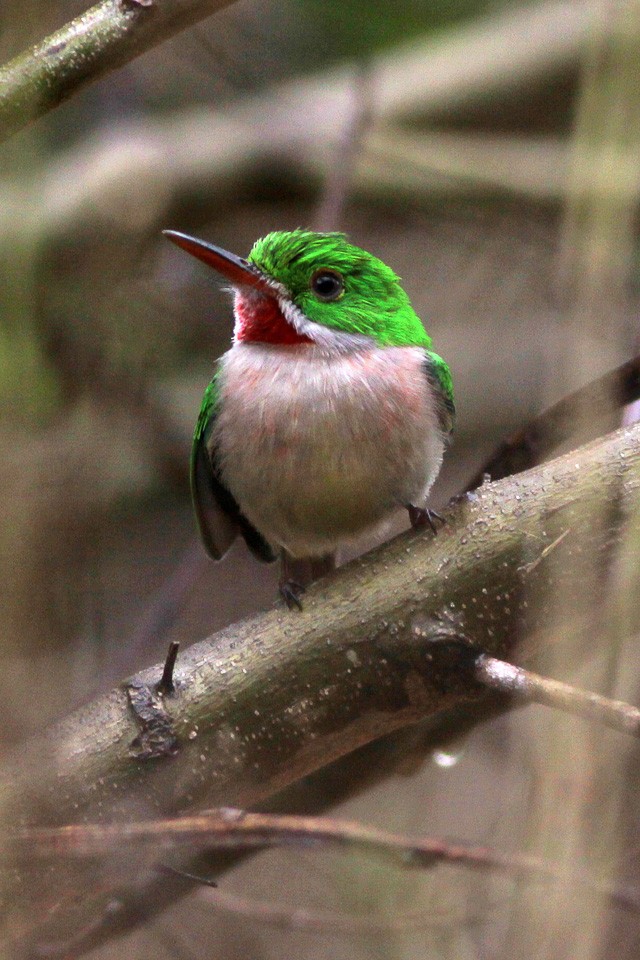Broad-billed Tody
A species of Todies Scientific name : Todus subulatus Genus : Todies
Broad-billed Tody, A species of Todies
Botanical name: Todus subulatus
Genus: Todies
Content
Description General Info
Description
The broad-billed tody is a small rotund bird with a short tail, distinctive bright green feathers on its back, head and wings, as well as a plain white breast tinged with yellow. Additionally, it has a striking red throat, pale pink flanks, slate-colored irises and bright yellow on its underside, where its body meets its tail. Moreover, the broad-billed tody has the widest bill of the tody family, measuring 0.6 centimeters wide and 2.1 centimeters long, the upper part of which is black, while its lower part is entirely red. The broad-billed tody has short, rounded feathers that are not streamlined for efficient flight. Its body measures 11.5 centimeters tall and it weighs approximately 7.5 grams, making it the largest bird of the genus Todus. The females and males are nearly indistinguishable, though the juveniles can be distinguished by the absence of the red throat, instead having pale yellow throats somewhat tinged with red, as well as shorter bills and gray-streaked breasts. Tody eggs are the smallest eggs of the Coraciiformes, measuring 1.6 centimeters by 1.4 centimeters and weighing approximately 1.4 grams. The eggs are glossy white, with no markings, though they often pick up a reddish tint from dirt stains, as well as a rosy tinge from the large orange/red yolk inside, necessary to sustain their unusually long incubation time. 
Size
12 cm
Nest Placement
Cavity
Feeding Habits
Broad-billed Tody's primary diet consists of insects. Utilizing a sit-and-wait hunting strategy, broad-billed Tody captures prey from its perch. Distinguished by its robust bill, broad-billed Tody prefers insect larvae, showing specialized feeding adaptation among todies.
Habitat
Broad-billed Tody typically inhabits open scrublands and semi-desert areas at lower elevations, thriving in both pristine and secondary forests. These birds are adapted to various forest types, including pine and scrub forests, and can also be found in cultivated landscapes like shade coffee plantations. Mangroves represent another habitat component for broad-billed Tody. Overall, their range spans broad geographical regions with a focus on areas characterized by a mix of forested and open environments. Broad-billed Tody occasionally joins mixed-species flocks, highlighting its adaptability to different habitats within its range.
Dite type
Insectivorous
General Info
Feeding Habits
Bird food type
Distribution Area
The broad-billed tody is endemic to Hispaniola (Dominican Republic and Haiti). It shares the island with another species of tody, the narrow-billed tody (Todus angustirostris), although the two species are geographically separated for much of the island, excluding specific pine forests and mangroves, where the two species can be seen flocking together. The broad-billed tody inhabits primarily low elevations, ranging from sea level to 1700 meters, and is also more prevalent in the Dominican Republic than Haiti. It prefers arid habitats containing low-land scrubs, sub-desert habitats with plentiful cacti and agave, as well as shaded coffee plantations and pine forests. Despite being a tropical bird, it is rarely seen in dense rainforest and dislikes wet conditions. The broad-billed tody is not a migratory species, and is instead completely sedentary. During the breeding season, the breeding pair will remain within the same territory for the duration of the season, though during the non-breeding months, the tody will forage slightly further from its home range and may join a mixed flock with the narrow-billed tody temporarily. When the breeding season begins again, the tody will stay close to its original territory and maintain it year to year. The juveniles also do not travel far once they leave the next. The first suitable territory that they will claim will be only a few kilometers away from their original home. 
Species Status
According to the IUNC Red List of Threatened Species, the broad-billed tody is categorized "of least concern" regarding geographic range, population and habitat. The species occupies a large area on Hispaniola, estimated to be 121,000 kilometers squared. Furthermore, the population does seem to be in decline, but not at a fast enough rate to be considered threatened. Human development has partly helped the broad-billed tody in some ways, the building of ditches and trail sides having created the embankments that the todies seem to prefer to dig their burrows, as well as the growth of coffee plantations grown under canopies providing more shelter and food for the broad-billed tody. However, coffee corporations have realized that growing coffee directly under the sun creates a more economical, but lower-quality product, which, coupled with the use of pesticides for local hotel resorts, has accelerated the habitat destruction of broad-billed todies. In regards to the conservation of this species, efforts must be made to protect wooded habitats and prevent further deforestation. Finally, encouraging population growth in wooded areas would be simple, needing only the return to canopy-grown coffee plantations and providing man-made embankments to encourage reproductive success. 
